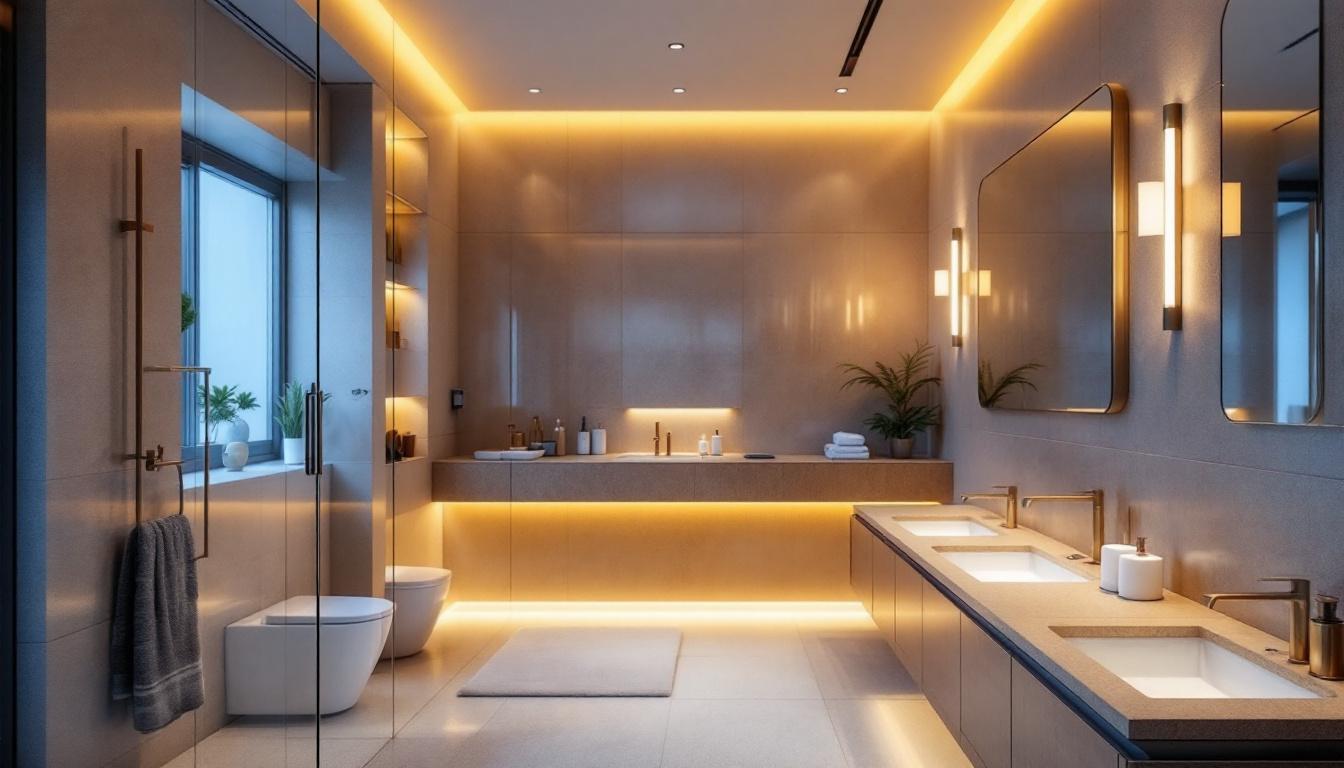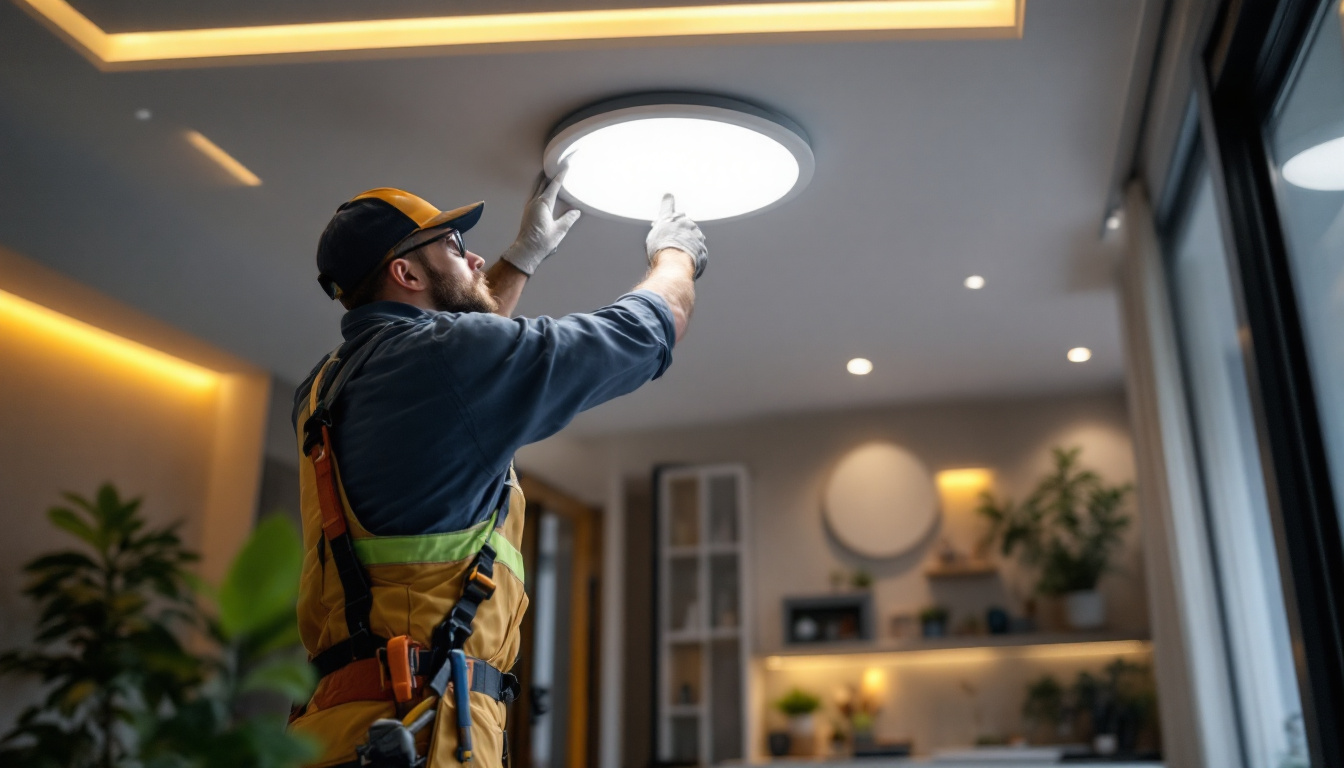
Recessed lighting has become a popular choice for bathroom illumination, providing a sleek and modern aesthetic while ensuring functionality. This guide is tailored for lighting contractors who are looking to enhance their knowledge and skills in the installation and design of recessed lighting specifically for bathrooms. It covers essential aspects such as planning, installation techniques, fixture selection, and safety considerations.
Recessed lighting, often referred to as can lighting or pot lighting, involves fixtures that are installed into the ceiling, creating a clean and unobtrusive look. This type of lighting is particularly beneficial in bathrooms, where space can be limited and aesthetics are crucial. The seamless integration of these fixtures not only enhances the visual appeal of the room but also allows for a more spacious feel, making it a popular choice among homeowners and designers alike.
When properly designed, recessed lighting can serve multiple purposes: providing general illumination, accentuating features, and offering task lighting for specific areas such as mirrors and vanities. Understanding how to effectively incorporate recessed lighting into bathroom designs is key for lighting contractors. The placement and type of bulbs used can dramatically affect the ambiance, ensuring that the bathroom is both functional and inviting.
There are various types of recessed lighting fixtures available, each serving different purposes. The most common types include:
Recessed lighting offers numerous advantages in bathroom settings. Firstly, it maximizes space by eliminating bulky fixtures that can overwhelm smaller areas. Secondly, it provides even illumination, reducing shadows that can make tasks like shaving or applying makeup more difficult. The ability to adjust the brightness and color temperature of recessed lights can also enhance the mood, allowing for a relaxing atmosphere during a long soak in the tub or a bright, energizing light for morning routines.
Moreover, recessed lighting can be strategically placed to highlight architectural features or decorative elements, enhancing the overall aesthetic of the bathroom. This versatility allows contractors to create a tailored lighting design that meets the specific needs of their clients. For instance, using dimmable LED recessed lights can create a spa-like environment, while focused lighting can draw attention to unique tile work or artwork. Additionally, incorporating smart lighting technology can enable homeowners to control their lighting with ease, adjusting settings based on time of day or personal preference, further enhancing the functionality and enjoyment of their bathroom space.
Effective planning is crucial for achieving the desired lighting effect in a bathroom. Contractors should consider the size of the space, the height of the ceiling, and the specific areas that require illumination.
A well-thought-out layout not only improves functionality but also enhances the visual appeal of the bathroom. It is essential to strike a balance between general lighting and task lighting, ensuring that all areas are adequately illuminated.
When planning the layout for recessed lighting in bathrooms, several factors should be taken into account:
Selecting the appropriate fixtures is a critical step in the design process. The choice of fixtures can significantly impact the overall look and functionality of the bathroom lighting.
Contractors should consider factors such as the size of the fixtures, the type of bulb used, and the color temperature to achieve the desired ambiance. Additionally, energy efficiency should be a priority, as LED options are increasingly popular due to their longevity and reduced energy consumption.
Fixture size plays a vital role in the overall design. Larger fixtures may be more suitable for spacious bathrooms, while smaller fixtures can complement compact areas without overwhelming the space. The style of the fixtures should also align with the bathroom’s decor, whether it’s modern, traditional, or transitional.
Contractors should explore a variety of trim styles, such as baffle, reflector, and adjustable trims, to enhance the aesthetic appeal and functionality of the lighting. Each trim style can create a different effect, influencing the distribution and intensity of light.
The type of bulb chosen for recessed lighting can affect both the quality of light and energy efficiency. LED bulbs are highly recommended due to their long lifespan and lower energy consumption compared to incandescent or halogen bulbs.
Color temperature is another important consideration. For bathrooms, a color temperature between 2700K and 3000K is typically ideal, as it provides a warm, inviting glow that complements skin tones and creates a relaxing atmosphere.
Proper installation techniques are essential for ensuring the safety and functionality of recessed lighting in bathrooms. Contractors must adhere to local building codes and safety standards throughout the installation process.
Before installation, it is crucial to plan the electrical layout and ensure that all necessary components, such as wiring and junction boxes, are in place. This preparation will facilitate a smoother installation process and reduce the risk of complications.
When installing recessed lighting, contractors must pay close attention to electrical requirements. It is important to ensure that the circuit can handle the load of the fixtures being installed. Additionally, using a dedicated circuit for bathroom lighting can prevent overloads and ensure consistent performance.
All wiring should be properly secured and protected, especially in areas where moisture is present. Using moisture-rated fixtures and ensuring proper sealing can help prevent damage and maintain safety standards.
The installation process typically involves cutting holes in the ceiling, securing the fixtures, and connecting the wiring. It is important to use the appropriate tools and techniques to avoid damaging the ceiling or the fixtures.
Once the fixtures are installed, testing the lighting is essential to ensure that everything is functioning correctly. This step allows contractors to make any necessary adjustments before completing the project.
Safety is paramount when working with electrical installations, especially in moisture-prone areas like bathrooms. Contractors must adhere to safety guidelines to protect both themselves and their clients.
Using the right fixtures, such as IC-rated options, can help prevent overheating and reduce fire hazards. Additionally, ensuring that all electrical components are rated for wet or damp locations is crucial for maintaining safety standards.
Bathrooms are inherently humid environments, and moisture protection is a critical consideration for recessed lighting. Fixtures should be rated for damp or wet locations to prevent water damage and electrical hazards.
Installing vapor barriers and ensuring proper ventilation can also help mitigate moisture-related issues. Contractors should educate clients on the importance of maintaining a well-ventilated bathroom to prolong the life of the lighting fixtures.
All installations must comply with local building codes and regulations. This includes adhering to guidelines regarding electrical work, fixture placement, and safety standards. Contractors should stay informed about any changes in regulations to ensure compliance and protect their clients.
Conducting a final inspection post-installation can help identify any potential issues and ensure that the project meets all safety requirements before handing it over to the client.
Recessed lighting can significantly enhance the overall design of a bathroom when combined with other lighting elements. Layering different types of lighting can create a more dynamic and functional space.
Incorporating wall sconces, pendant lights, or decorative fixtures alongside recessed lighting can provide additional layers of illumination and enhance the aesthetic appeal of the bathroom.
Combining recessed lighting with other lighting types allows for greater flexibility in design and functionality. For instance, wall sconces can provide flattering light for mirrors, while recessed fixtures can offer general illumination.
Contractors should consider the specific needs of their clients when designing a layered lighting plan. This approach not only improves functionality but also creates a visually appealing environment that meets the client’s preferences.
Smart lighting solutions are becoming increasingly popular in modern bathrooms. Integrating smart technology allows for greater control over lighting levels and can enhance the overall user experience.
Contractors should explore options for smart dimmers, color-changing bulbs, and automated lighting systems that can be controlled via smartphones or voice commands. These features can add convenience and luxury to the bathroom experience.
Recessed lighting offers a versatile and modern solution for illuminating bathrooms, combining functionality with aesthetic appeal. For lighting contractors, understanding the intricacies of recessed lighting installation, from planning and fixture selection to safety considerations, is essential for delivering high-quality results.
By staying informed about the latest trends and technologies in lighting design, contractors can enhance their skills and provide exceptional service to their clients. Whether working on new constructions or renovations, recessed lighting can transform a bathroom into a beautifully lit sanctuary.
Ready to elevate your bathroom lighting projects with the sleek appeal of recessed lighting? Look no further than LumenWholesale for all your lighting needs. Our extensive selection of spec-grade lighting products is available at unbeatable wholesale prices, ensuring you get the best value for your investment. Say goodbye to local distributor markups and hello to high-performance lighting that meets the highest industry standards. Plus, with free shipping on bulk orders, you can stock up on premium lighting effortlessly. Don’t compromise on quality or price. Experience the convenience of shopping with LumenWholesale today by visiting our Wholesale Lighting at the Best Value collection.

Discover why lighting contractors should prioritize indoor riding arenas in their projects.

Discover how innovative electrical cords are revolutionizing the lighting industry, enhancing efficiency and safety for contractors.

Discover essential insights and expert tips for lighting contractors on selecting and installing recessed LED ceiling lights.

Discover the pitfalls lighting contractors often encounter with light accessories.